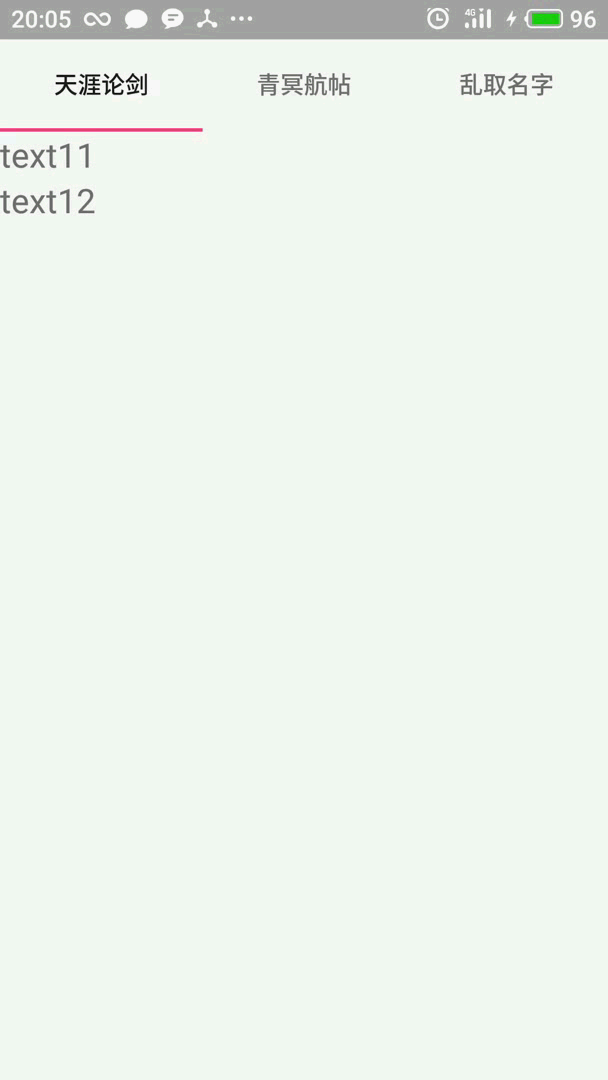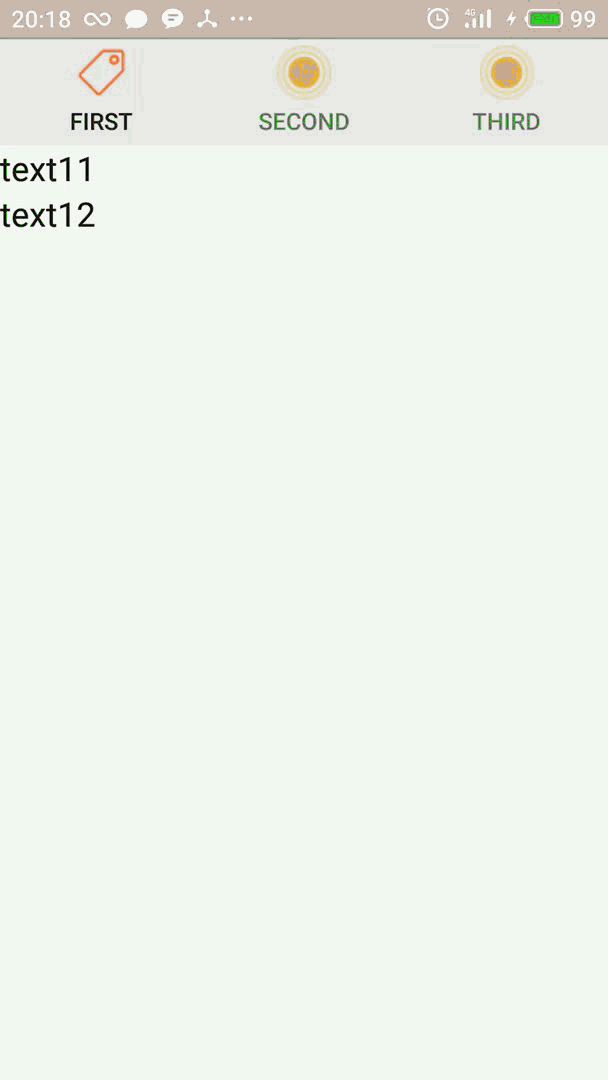Android-TabHost选项卡-疑难全解
前言:
虽然现在谷歌已经不推荐使用TabHost,但是初学者还是很有必要接触下这一成金的经典的,本文将介绍纤细介绍这一空间的使用,以及大家可能遇到的问题。注:文末给出完整实现代码
三个问题:
1. 无法显示TabHost
2. 添加图片 + 文字 无法同时
3. 说在最后:点击事件
4. 底部导航无法实现
现在
从问题出发:
问题一:无法显示 TabHost
很多人调用TabHost的方法是:
setContentView(R.layout.activity_main);
tabHost = getTabHost();然后发现啥也没有,一脸蒙圈。。。 在这里建议大家采用遮掩的调用方法:
LayoutInflater.from(this).inflate(R.layout.activity_main,
tabHost.getTabContentView(), true);成功后的页面:
注:UI 略丑请忽视
问题二:图片、文字无法同时添加
好了,很多人辛辛苦苦把界面搞出来了,可能想搞个底部菜单 加个图片,结果凉凉 半天搞不出来 ,这里介绍一个方法 ,由于TabHost本身图片、文字冲突 ,无法添加,这是我们就得把目光迁移到自定义view上:本段参考自:https://www.cnblogs.com/lovecode/articles/2652510.html
首先在/layout下建立自定义view名为:tab_indicator.xml文件
接着,紧随其后在/drawable下添加:tab_info.xml文件:
这些都搞定之后,就可以在活动中调用了:
首先在活动中先建立AddTab()方法:
private void AddTab(String label, int drawableId) {
Intent intent = new Intent(this, TextActivity.class);
TabHost.TabSpec spec = tabHost.newTabSpec(label);
View tabIndicator = LayoutInflater.from(this).inflate(R.layout.tab_indicator, getTabWidget(), false);
TextView title = (TextView) tabIndicator.findViewById(R.id.title);
title.setText(label);
ImageView icon = (ImageView) tabIndicator.findViewById(R.id.icon);
icon.setImageResource(drawableId);
spec.setIndicator(tabIndicator);
spec.setContent(intent);
tabHost.addTab(spec);
}终于我们。。。:
成功了!!!
问题三:添加监听事件
这个无脑 只要 id 匹配就行了,直接上代码:
tabHost.setOnTabChangedListener(new TabHost.OnTabChangeListener(){
@Override
// tabId是newTabSpec参数设置的tab页名,并不是layout里面的标识符id
public void onTabChanged(String tabId) {
if (tabId.equals("tab1")) { //第一个标签
Toast.makeText(MainActivity.this, "点击标签页一", Toast.LENGTH_SHORT).show();
}else if (tabId.equals("tab2")) { //第二个标签
Toast.makeText(MainActivity.this, "点击标签页二", Toast.LENGTH_SHORT).show();
}else if (tabId.equals("tab3")) { //第三个标签
Toast.makeText(MainActivity.this, "点击标签页三", Toast.LENGTH_SHORT).show();
}
}
});暂时能记起来的 疑难就这些了 如果还有请给我留言 我尽力解答。。
附上布局与实现:
布局:
实现:
public class MainActivity extends TabActivity {
TabHost tabHost;
@Override
protected void onCreate(Bundle savedInstanceState) {
super.onCreate(savedInstanceState);
// setContentView(R.layout.activity_main);
tabHost = getTabHost();
LayoutInflater.from(this).inflate(R.layout.activity_main,
tabHost.getTabContentView(), true);
AddTab("tab1", R.drawable.tab_info);
AddTab("tab2", R.drawable.tab_info);
AddTab("tab3", R.drawable.tab_info);
//
//标签切换事件处理,setOnTabChangedListener
tabHost.setOnTabChangedListener(new TabHost.OnTabChangeListener(){
@Override
// tabId是newTabSpec参数设置的tab页名,并不是layout里面的标识符id
public void onTabChanged(String tabId) {
if (tabId.equals("tab1")) { //第一个标签
Toast.makeText(MainActivity.this, "点击标签页一", Toast.LENGTH_SHORT).show();
}else if (tabId.equals("tab2")) { //第二个标签
Toast.makeText(MainActivity.this, "点击标签页二", Toast.LENGTH_SHORT).show();
}else if (tabId.equals("tab3")) { //第三个标签
Toast.makeText(MainActivity.this, "点击标签页三", Toast.LENGTH_SHORT).show();
}
}
});
}
private void AddTab(String label, int drawableId) {
Intent intent = new Intent(this, TextActivity.class);
TabHost.TabSpec spec = tabHost.newTabSpec(label);
View tabIndicator = LayoutInflater.from(this).inflate(R.layout.tab_indicator, getTabWidget(), false);
TextView title = (TextView) tabIndicator.findViewById(R.id.title);
title.setText(label);
ImageView icon = (ImageView) tabIndicator.findViewById(R.id.icon);
icon.setImageResource(drawableId);
spec.setIndicator(tabIndicator);
spec.setContent(intent);
tabHost.addTab(spec);
}
}ps:新建的layout和/drawable里的xml文件在问题给过,这里就不反复给了。
问题四:底部导航效果无法实现
底部导航的参见方法是把TabWidget放在FrameLayout后面,但是啧啧。。。
中间内容前面给出 这里省略
你会发现并没有什么 卵用 !!!呕!!,so:
百度了半天找不到问题所在,然后。。。修改下MainActivity
@Override
protected void onCreate(Bundle savedInstanceState) {
super.onCreate(savedInstanceState);
//原来
// tabHost = getTabHost();
// LayoutInflater.from(this).inflate(R.layout.activity_main,
// tabHost.getTabContentView(), true);
//修改后
setContentView(R.layout.activity_main);
tabHost = getTabHost();
tabHost.setup(this.getLocalActivityManager());
AddTab("tab1", R.drawable.tab_info);
AddTab("tab2", R.drawable.tab_info);
AddTab("tab3", R.drawable.tab_info);
//标签切换事件处理,setOnTabChangedListener
iniClick();
}注:此处我已经将点击事件封装到方法中
最后:全剧终
哦,还没有且等我放下最后的图。。
啧啧,搞定


